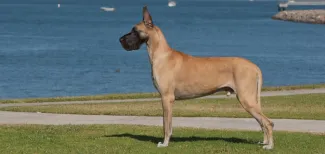DOWNLOAD PDF
A powerful, muscled fawn Great Dane named “Logan” (BISS CH Surfside Lera Wave Ryder AOM) sired 11 champions out of 27 puppies whelped from his early natural breedings. At age 5 when he could have been earning points for Top Stud Dog, Logan was no longer able to produce puppies.
Vicki Kimbell of Sierra Vista, Arizona, lamented the premature loss of fertility in the handsome male. “Logan passed on to his offspring beautiful fronts, and they had a true shoulder layback even when he was bred to bitches that didn’t have this,” says Kimbell, a longtime owner of Great Danes.
Joy DeGruccio of Costa Mesa, California, was a co-owner of Logan. A longtime breeder of Great Danes under the Tydwind prefix, DeGruccio, who is a trustee of the Great Dane Club of America (GDCA) Charitable Trust, learned that other stud dog owners were likewise experiencing early reproduction problems in their dogs and were concerned about the emerging health issue.
Volunteering to research studies of stud dog reproductive health for the GDCA Charitable Trust, DeGruccio found an expert at the University of California-Davis. Stuart Meyers, DVM, PhD, DACT, professor of anatomy, physiology and cell biology, specializes in male fertility and sperm biology. DeGruccio reached out to Dr. Meyers to learn if he would do a fertility study in male Great Danes. Dr. Meyers welcomed the opportunity to continue exploring factors that affect sperm function in dogs and how they differ among breeds and age groups.
“Extrapolating between breeds and age groups is challenging because the normal distribution of semen and fertility characteristics varies among breeds,” Dr. Meyers explains. “This is a study of sperm quality. We do not know how fertile these males have been, but this is an important first step in sorting out how factors underlying sperm function can drive age-related sperm quality losses in Great Danes.”
With funding support of $150,000 from GDCA and the GDCA Charitable Trust, Dr. Meyers and his team began collecting semen samples. They drew 25 semen samples at the 2018 GDCA National Specialty in Topeka, Kansas, 25 samples at the 2019 Northern California Great Dane Specialty Show in Lodi, and 50 samples at the 2019 GDCA National Specialty in Virginia Beach, Virginia. Owners received a complete analysis of their individual dog’s semen quality report.
The study is the largest male fertility study conducted in a single breed. The aim is to determine whether there is a relationship between a dog’s age and sperm parameters that determine his viability as a reproducer. “As a giant breed, Great Danes age rapidly and have a relatively short life span,” Dr. Meyers says. “When males become subfertile in middle age, years before they should, it is concerning.”

